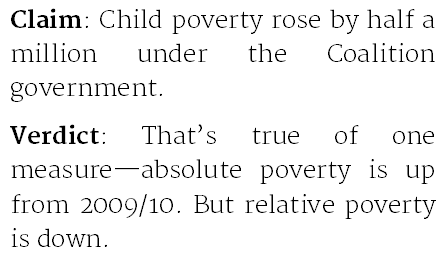What was claimed
Child poverty rose by half a million under the Coalition government.
Our verdict
That's true of one measure—absolute poverty is up from 2009/10. But relative poverty is down.
What was claimed
Child poverty rose by half a million under the Coalition government.
Our verdict
That's true of one measure—absolute poverty is up from 2009/10. But relative poverty is down.
"Child poverty rose by half-a-million under the last government to over four million."
Jeremy Corbyn, 15 September 2015
That's true of absolute child poverty, but over the same period the number of children in relative poverty fell.
After housing costs are taken into account, the number of children living in absolute poverty is up from 3.6 million in 2009/10 to 4.1 million in 2013/14. It's up in percentage terms too—from 27% to 31% of children in the UK. Those are the latest figures—we won't be able to assess the change over the whole of the last parliament until we have figures from 2014/15.
But the number of children in relative poverty (again, after housing costs) fell in the same period. It fell from 3.9 million in 2009/10 to 3.6 million the following year, before rising to 3.7 million in 2013/14.
Neither measure is clearly superior to the other, so it's not helpful to highlight one of them in isolation. As the Institute for Fiscal Studies puts it, absolute and relative measures tell us different things, and "there is nothing to be gained from ignoring some of this information".
The difference between absolute and relative poverty—a brief explanation
A child is in relative poverty (also called relative low income) if they live in a household with income below 60% of the median household income, adjusted for the household's size and composition.
Absolute poverty is more complex. The official measure used by the UK government is set relative to what people earned in 2010/11. A child is in absolute poverty if they live in a household earning less than 60% of the 2010/11 median, after adjusting for inflation and again for household size and composition.
Because median incomes have grown more slowly than RPI inflation over the period, the absolute "low-income threshold" is higher than the relative one. That means some families have incomes that are over 60% of today's median level, and therefore aren't counted as being in relative poverty, but their income (once adjusted) would have been less than 60% of 2010 levels, meaning they're in poverty in absolute terms.
We have more details on how poverty is measured in a longer guide on the subject.
Full Fact fights for good, reliable information in the media, online, and in politics.
Bad information ruins lives. It promotes hate, damages people’s health, and hurts democracy. You deserve better.